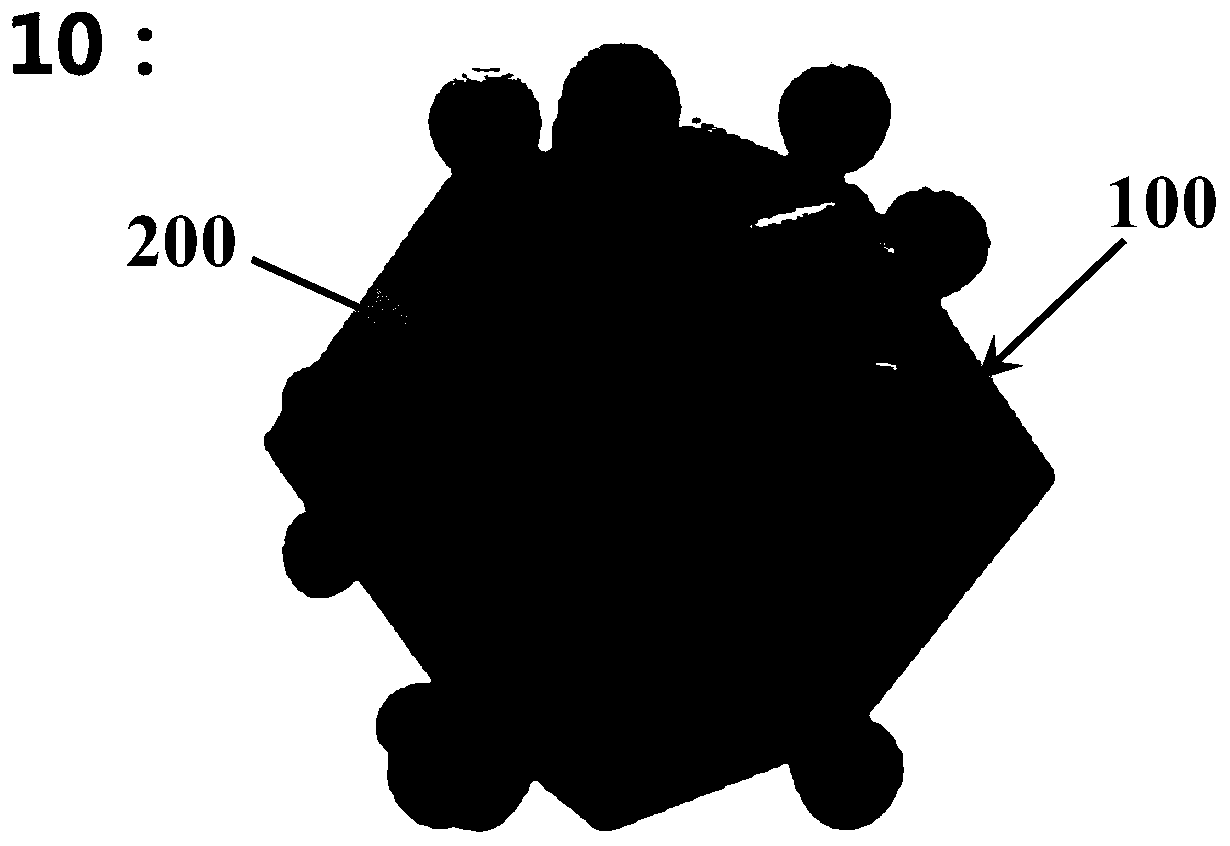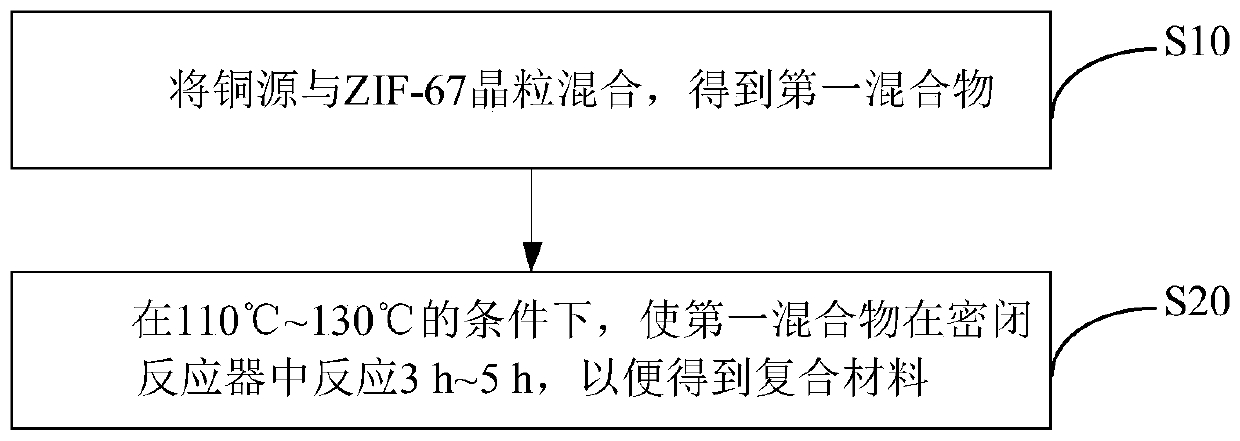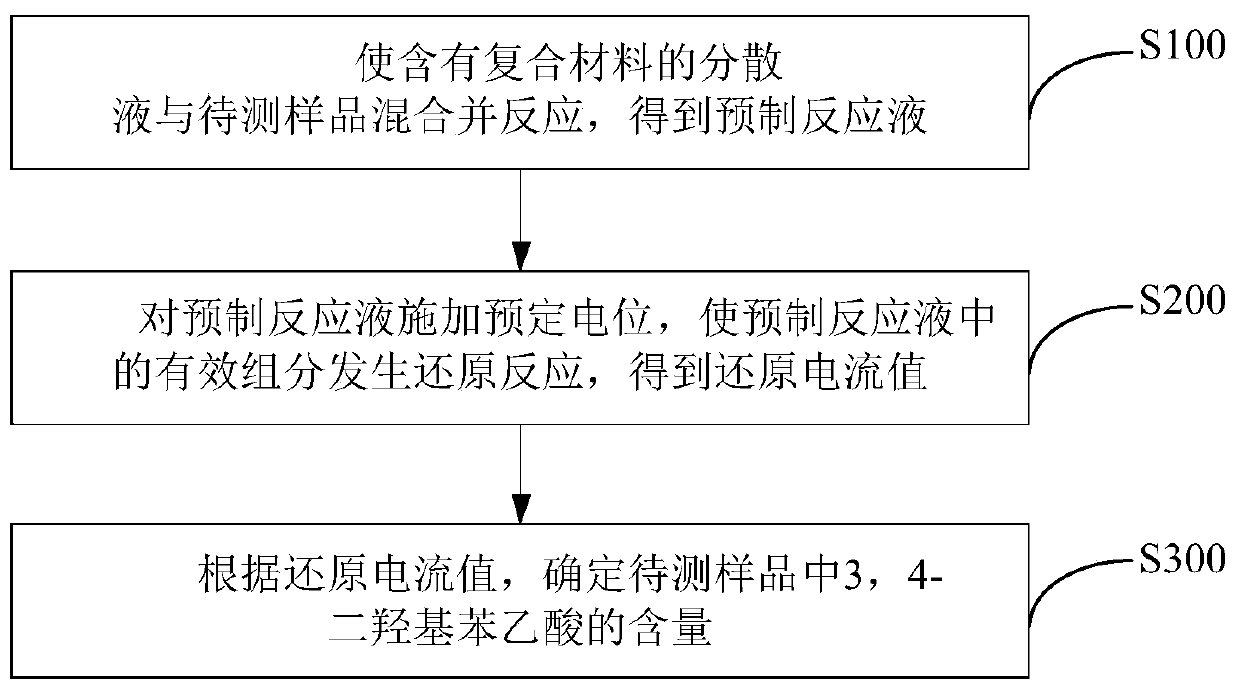Composite material and preparation method and application thereof, and method for detecting 3, 4-dihydroxyphenylacetic acid
A technology of dihydroxyphenylacetic acid and composite materials, which is applied in the chemical field and can solve problems that need to be improved
- Summary
- Abstract
- Description
- Claims
- Application Information
AI Technical Summary
Problems solved by technology
Method used
Image
Examples
Embodiment 1
[0066] The method for preparing the composite material and the prepared composite material:
[0067] Dissolve 5g of 2-methylimidazole in 19mL of water, stir until transparent, then add 0.2mL of a mixed alcohol solution containing 0.0456g of PVP (the volume ratio of methanol, ethanol, and isopropanol is 1:1:1) , and finally 0.2925g of Co(NO 3 ) 2 ·6H 2 O was dissolved in 1mL of water and added to the above solution, the solution immediately turned blue-purple, and stirred at room temperature for 4h. After the reaction was finished, it was washed twice with ethanol, and dried at 60° C. to obtain ZIF-67 grains.
[0068] 58 mg of the ZIF-67 crystal grains obtained above are taken and dissolved in 10 mL of ethanol solution, and 5 mL contains 25 mg Cu (NO 3 ) 2 ·3H 2 The ethanol solution of O was injected into it, and then the mixed solution was moved to a 20mL hydrothermal reaction kettle, and reacted at 120°C for 4h. After the reaction was completed, it was washed with ethan...
Embodiment 2
[0086] Detect the method of 3,4-dihydroxyphenylacetic acid content in the sample to be tested:
[0087] The concentration of the composite dispersion was fixed at 500 μg / mL, and DOPAC was detected using an electrochemical online detection platform.
[0088] An electrochemical online detection platform is constructed by using a syringe pump, two syringes, microdialysis tubing, and an electrochemical flow cell. The dispersion of the composite material with a fixed concentration of 500 μg / mL in one syringe, and the DOPAC standard solution with a concentration of 0.5, 1 μM, 2 μM, 5 μM, 7 μM, 10 μM, 15 μM, and 20 μM in the other syringe, were real-time analyzed using an electrochemical flow cell. Record the reduction current when standard solutions with different concentrations are connected to the electrochemical online detection platform. refer to Figure 7 In Figure A, the illustration shows the linear relationship between the concentration of DOPAC and the reduction current v...
Embodiment 3
[0094] The method for preparing the composite material and the prepared composite material:
[0095] Dissolve 5g of 2-methylimidazole in 19mL of water, stir until transparent, then add 0.2mL of a mixed alcohol solution containing 0.0456g of PVP (the volume ratio of methanol, ethanol, and isopropanol is 1:1:1) , and finally 0.2925g of Co(NO 3 ) 2 ·6H 2 O was dissolved in 1mL of water and added to the above solution, the solution immediately turned blue-purple, and stirred at room temperature for 4h. After the reaction was finished, it was washed twice with ethanol, and dried at 60° C. to obtain ZIF-67 grains.
[0096] 24 mg of the ZIF-67 crystal grain obtained above is taken and dissolved in 10 mL of ethanol solution, and 5 mL contains 59 mg Cu (NO 3 ) 2 ·3H 2 The ethanol solution of O was injected into it, and then the mixed solution was moved to a 20mL hydrothermal reaction kettle, and reacted at 120°C for 4h. After the reaction was completed, it was washed with ethanol...
PUM
| Property | Measurement | Unit |
|---|---|---|
| Particle size | aaaaa | aaaaa |
| Particle size | aaaaa | aaaaa |
| Particle size | aaaaa | aaaaa |
Abstract
Description
Claims
Application Information
 Login to View More
Login to View More - R&D
- Intellectual Property
- Life Sciences
- Materials
- Tech Scout
- Unparalleled Data Quality
- Higher Quality Content
- 60% Fewer Hallucinations
Browse by: Latest US Patents, China's latest patents, Technical Efficacy Thesaurus, Application Domain, Technology Topic, Popular Technical Reports.
© 2025 PatSnap. All rights reserved.Legal|Privacy policy|Modern Slavery Act Transparency Statement|Sitemap|About US| Contact US: help@patsnap.com



